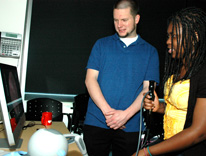
By Chris Casey | University Communications
AURORA, Colo. - In less than an hour, high students peered through microscopes to see mutations in zebrafish and view bones and cartilage in embryonic mice. They also used a device that allows surgeons to anesthetize tissue deep inside the human body.
Those were just a sampling of the six labs that offered demonstrations to students from Aurora Public Schools this morning in the School of Medicine. About 30 students toured the labs in the morning and another 60 in the afternoon.
The outreach program is delivered annually by faculty and researchers in Cell and Developmental Biology Department.
"It's fun to see the students," said Ernie Salcedo, PhD, an instructor in Cell and Developmental Biology, who gave them an introduction about the Anschutz Medical Campus. "They always have good questions, and it's fun to get them into the labs and show them the things we're doing."
The high school students broke into groups of five or six and spent about 15 minutes in each lab:
- Nervous system development in zebrafish (Kristin Artinger, PhD, assistant professor, Craniofacial Biology)
- Tasty development -- tongues and taste buds in vertebrates (Linda Barlow, PhD, associate professor, Cell and Developmental Biology)
- Nuclear magnetic resonance (Brad Bendiak, PhD, associate professor, Cell and Developmental Biology)
- A tour of our chemical senses (Diego Restrepo, PhD, professor, and Professor Tom Finger, Cell and Developmental Biology)
- Cellular control of vertebrate embryonic development (Lee Niswander, PhD, professor, Pediatrics Developmental Biology)
- Simulation scenarios (Vic Spitzer, PhD, associate professor, Cell and Developmental Biology)
In the embryonic development lab, graduate students Juliette Petersen and Laura Harmacek discussed their study of neural tube defects. They explained how the study of embryonic mice has implications for helping understand the development of spina bifida -- the failure of the neural tube around the spinal cord to completely close -- in human beings.
Dorothy Agyemang, a freshman at William Smith High School, enjoyed the demonstrations.
"It's really cool because you can like feel things," she said, after operating the surgical device used to anesthetize tissue -- in this case the wall of a human bladder.
Agyemang said she wants to become a pharmacist. "This (pointing to the surgical device) shows me how to give medicine and learn about what's going on in the body. Just how the body works and what makes things go wrong."
(Photo: Dorothy Agyemang, an Aurora Public Schools student, operates a surgical device during a lab tour outreach program in the School of Medicine. Looking on is Adam Lawson, a professional research assistant in the Center for Human Simulation.)
Contact: christopher.casey@ucdenver.edu
